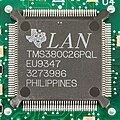



Token Ring is a physical and data link layer computer networking technology used to build local area networks. It was introduced by IBM in 1984, and standardized in 1989 as IEEE 802.5. It uses a special three-byte frame called a token that is passed around a logical ring of workstations or servers. This token passing is a channel access method providing fair access for all stations, and eliminating the collisions of contention-based access methods.
Contents
- History
- 1985 IBM launch
- Gallery
- Comparison with Ethernet
- Operation
- Access control
- Multistation Access Units and Controlled Access Units
- Cabling and interfaces
- Technical details
- Frame types
- Active and standby monitors
- Token insertion process
- Optional priority scheme
- Interconnection with Ethernet
- Operating system support
- See also
- References
- General
- External links
Following its introduction, Token Ring technology became widely adopted, particularly in corporate environments, but was gradually eclipsed by newer iterations of Ethernet. The last formalized Token Ring standard that was completed was Gigabit Token Ring (IEEE 802.5z), published on May 4, 2001. [1]










